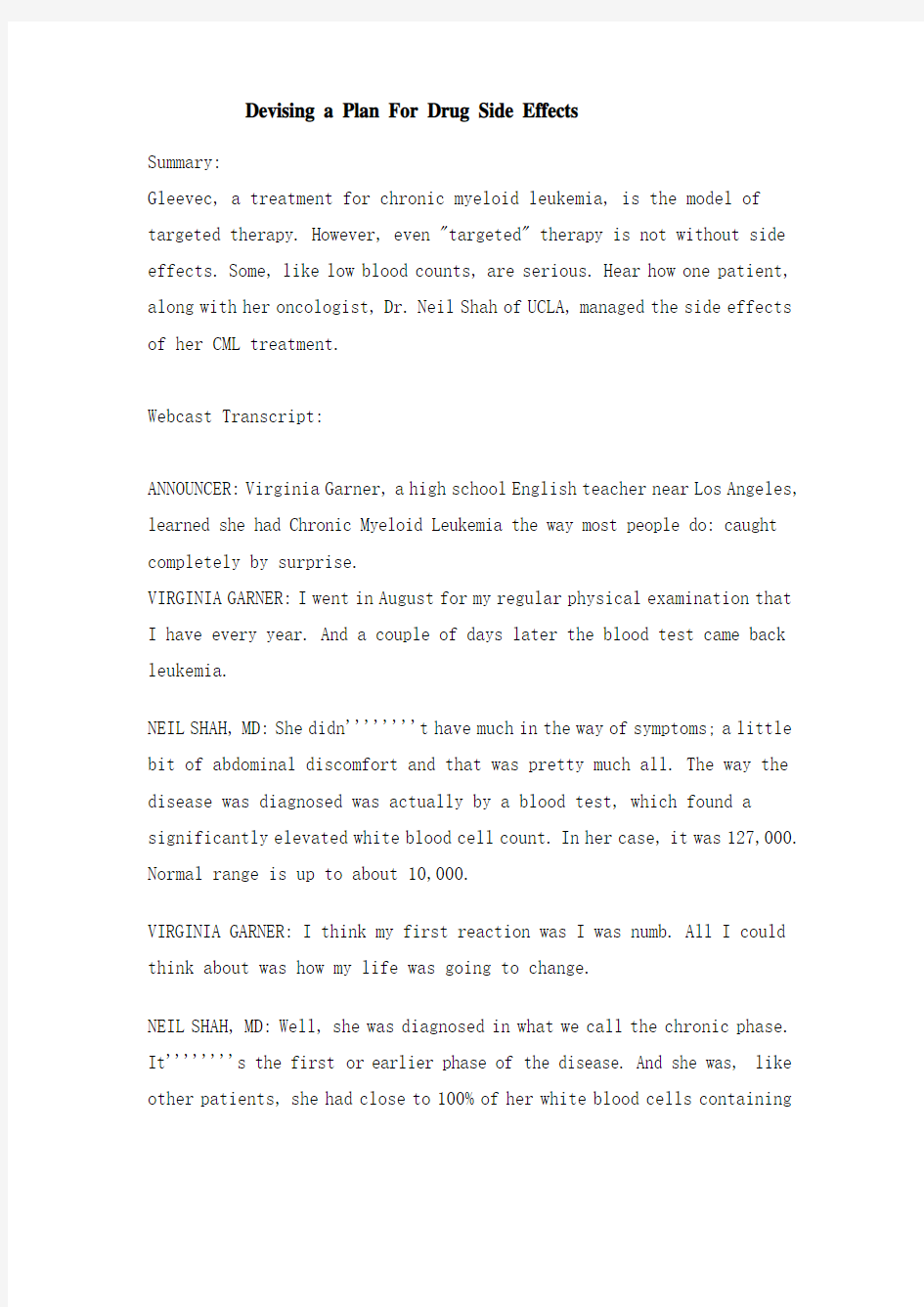Devising a Plan For Drug Side Effects


Devising a Plan For Drug Side Effects
Summary:
Gleevec, a treatment for chronic myeloid leukemia, is the model of targeted therapy. However, even "targeted" therapy is not without side effects. Some, like low blood counts, are serious. Hear how one patient, along with her oncologist, Dr. Neil Shah of UCLA, managed the side effects of her CML treatment.
Webcast Transcript:
ANNOUNCER: Virginia Garner, a high school English teacher near Los Angeles, learned she had Chronic Myeloid Leukemia the way most people do: caught completely by surprise.
VIRGINIA GARNER: I went in August for my regular physical examination that I have every year. And a couple of days later the blood test came back leukemia.
NEIL SHAH, MD: She didn''''''''t have much in the way of symptoms; a little bit of abdominal discomfort and that was pretty much all. The way the disease was diagnosed was actually by a blood test, which found a significantly elevated white blood cell count. In her case, it was 127,000. Normal range is up to about 10,000.
VIRGINIA GARNER: I think my first reaction was I was numb. All I could think about was how my life was going to change.
NEIL SHAH, MD: Well, she was diagnosed in what we call the chronic phase. It''''''''s the first or earlier phase of the disease. And she was, like other patients, she had close to 100% of her white blood cells containing
the Philadelphia chromosome, which is what we understand to be the molecular driver of the disease.
ANNOUNCER: In CML, that aberrant chromosome, the Philadelphia chromosome, interferes with the normal replication of white blood cells.
The only proven cure for CML is a bone marrow transplant. But that is a risky procedure, and risk increases with age. Virginia was not a good candidate. Instead, she underwent what was the best medical therapy at the time, interferon.
NEIL SHAH, MD: She was initially treated with interferon, which has been shown to be of significant clinical benefit in patients with chronic myeloid leukemia.
She had a response with respect to her white blood cell count coming down to normal, but there was no response with respect to the Philadelphia chromosome where all of her white blood cells still contain the Philadelphia chromosome.
ANNOUNCER: In 1999, Virginia found she had another option.
Her doctors at MD Anderson were planning a clinical trial for a new drug against CML, called Gleevec. Virginia enrolled.
The drug quickly normalized Virginia''''''''s blood counts, and reduced the percentage of her blood cells containing the Philadelphia chromosome, so-called "Ph-positive" cells.
VIRGINIA GARNER: It took two weeks and my blood counts were normal. About two weeks; that''''''''s all. It took a few months for my bone marrow to get down to miniscule amounts of the Ph-positive cells, but it''''''''s there.
ANNOUNCER: As with all drugs, side effects with Gleevec do occur. Some, like fluid retention, were mild, and easy to cope with. Abnormalities in Virginia''''''''s blood cell counts, however, were more serious.
NEIL SHAH, MD: Virginia''''''''s experience with Gleevec was notable for the development of swelling around the eyes, what we call periorbital edema as well as in the extremities. That didn''''''''t seem to bother her too much. More significantly for us, was she did develop some hematologic toxicity. Her hemoglobin fell and her platelet counts fell.
Her white count fell, which we wanted it to. It didn''''''''t fall to a dangerously low level. But the most significant toxicity she experienced was with respect to her platelets.
It was a potentially serious problem. The risk is that the patient may develop some spontaneous bleeding and we would like to try to avoid that.
ANNOUNCER: Gleevec was proving too important for Virginia to stop altogether. Instead, her doctors decided on a temporary halt, to give her platelet-producing bone marrow a rest.
NEIL SHAH, MD: Dose interruption was employed and then reinstitution of the drug once her counts had risen significantly.
VIRGINIA GARNER: I go for about three months on the dosage of Gleevec and then my platelets are low enough that I need to go off. I stay off for about two weeks and my platelets come back and I go back on the drug.
Interruptions in medical therapy can sometimes decrease the effectiveness of a drug. But Virginia''''''''s response to Gleevec remains strong.
NEIL SHAH, MD: Clearly in her case she''''''''s been on the drug now nearly five years and is doing remarkably well.
VIRGINIA GARNER: I''''''''m very happy that my experience with Gleevec is working out, even though I do have to take a rest from it occasionally.
